A hospice nurse outlines the 4 stages of the dying process.
Knowing the reality of death is crucial.
September 3rd 2024.

Death is something that happens to all of us. It's a natural part of life, but it's also something that many of us don't fully understand. Hospice nurse Julie McFadden wants to change that. She believes that education can decrease fear, and she wants to share her knowledge from years of experience in palliative care to demystify the topic of death.
In one of her TikTok videos, Julie answered a common question that she hears in her work: What does the dying process actually look like? She explains that the process can vary depending on how someone passes away and what they are passing away from, but if it's a natural progression rather than a sudden incident, there are a few things that typically happen to the body as the end draws near.
In the early stages of dying, which can begin around six months before someone's passing, the symptoms tend to be more generalized. Julie explains that a person may feel tired, lethargic, and may have a decreased appetite and social interaction. As the disease progresses, a person's strength may sharply decline, making it difficult for them to leave the house and causing them to sleep more than they are awake.
There is also a period of transitioning that typically occurs about a month before death. During this time, some people may experience a phenomenon known as "visioning," where they see deceased loved ones or pets. Julie says this is a common occurrence and can be comforting for the person. She also notes that it tends to happen when the person is alert and oriented.
As the person enters the final stage of life, known as actively dying, their body starts to shut down. This can be a scary and confusing time for loved ones who may not be familiar with the process. Julie explains that a person in this stage may be fully unconscious and may not have had food or water for days. They may also have changes in their breathing and metabolism, such as changes in skin color and temperature. They may also experience the "death rattle," a gurgling noise caused by fluid buildup in the throat and airways.
While it's natural for these things to be upsetting, Julie wants to assure people that this is a normal part of the dying process and that it is not causing any harm to their loved one. It's important to be educated about what death actually looks like, as movies and television often don't do it justice. When people see it in real life, they may feel scared or overwhelmed. But Julie wants to change that by sharing her knowledge and helping people to understand and prepare for the dying process.
So, while death may be something that happens to all of us, Julie wants to make sure that we are not afraid of it. Education can decrease fear, and by learning about the stages of dying, we can be better prepared to support our loved ones during this difficult time.
In one of her TikTok videos, Julie answered a common question that she hears in her work: What does the dying process actually look like? She explains that the process can vary depending on how someone passes away and what they are passing away from, but if it's a natural progression rather than a sudden incident, there are a few things that typically happen to the body as the end draws near.
In the early stages of dying, which can begin around six months before someone's passing, the symptoms tend to be more generalized. Julie explains that a person may feel tired, lethargic, and may have a decreased appetite and social interaction. As the disease progresses, a person's strength may sharply decline, making it difficult for them to leave the house and causing them to sleep more than they are awake.
There is also a period of transitioning that typically occurs about a month before death. During this time, some people may experience a phenomenon known as "visioning," where they see deceased loved ones or pets. Julie says this is a common occurrence and can be comforting for the person. She also notes that it tends to happen when the person is alert and oriented.
As the person enters the final stage of life, known as actively dying, their body starts to shut down. This can be a scary and confusing time for loved ones who may not be familiar with the process. Julie explains that a person in this stage may be fully unconscious and may not have had food or water for days. They may also have changes in their breathing and metabolism, such as changes in skin color and temperature. They may also experience the "death rattle," a gurgling noise caused by fluid buildup in the throat and airways.
While it's natural for these things to be upsetting, Julie wants to assure people that this is a normal part of the dying process and that it is not causing any harm to their loved one. It's important to be educated about what death actually looks like, as movies and television often don't do it justice. When people see it in real life, they may feel scared or overwhelmed. But Julie wants to change that by sharing her knowledge and helping people to understand and prepare for the dying process.
So, while death may be something that happens to all of us, Julie wants to make sure that we are not afraid of it. Education can decrease fear, and by learning about the stages of dying, we can be better prepared to support our loved ones during this difficult time.
[This article has been trending online recently and has been generated with AI. Your feed is customized.]
[Generative AI is experimental.]
0
0
Submit Comment





